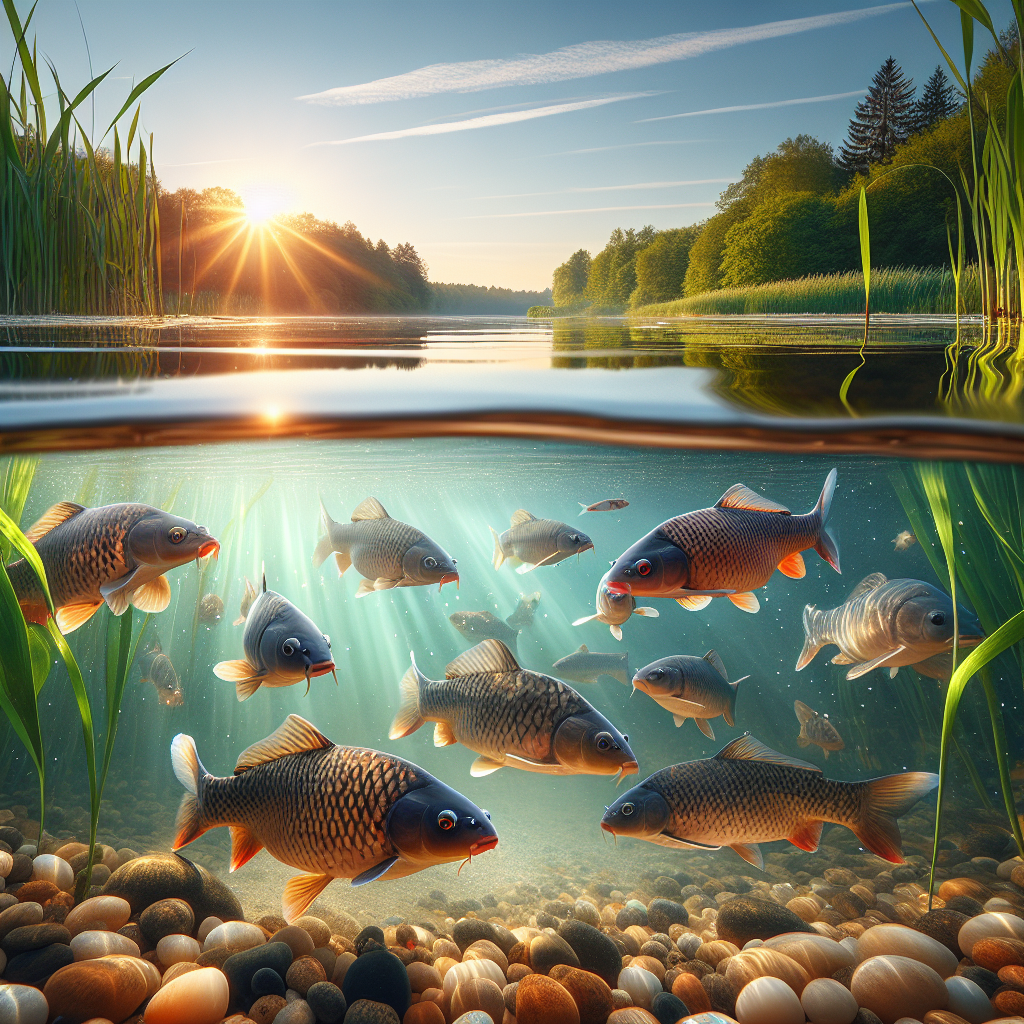The Environmental Impact of Carp: How These Invasive Fish Are Harming Ecosystems
Carp, a type of freshwater fish, have been causing quite a stir in recent years due to their negative impact on ecosystems. Originally from Asia, carp were introduced to North America in the 1800s for their value as a food source and for recreational fishing. However, their rapid reproduction and ability to adapt to various environments have led to them becoming one of the most invasive species in the world.
One of the main concerns surrounding carp is their effect on native fish populations. Carp are known to outcompete other fish for resources such as food and habitat. They are also known to consume large amounts of aquatic vegetation, which can lead to a decrease in oxygen levels and harm other species that rely on these plants for survival. This disruption of the natural balance can have a cascading effect on the entire ecosystem.
In addition to their impact on native fish, carp also pose a threat to other aquatic animals. They are known to stir up sediment on the bottom of lakes and rivers, which can smother the eggs of other fish and invertebrates. This can lead to a decline in these species and disrupt the food chain. Furthermore, carp are known carriers of diseases and parasites that can be harmful to other fish and even humans.
The environmental impact of carp is not limited to just aquatic ecosystems. They also have a negative effect on water quality. As mentioned earlier, carp consume large amounts of vegetation, which can lead to an increase in algae growth. This can result in algal blooms, which can be toxic to other aquatic life and make the water unsuitable for recreational activities such as swimming and boating. In addition, the disturbance of sediment by carp can release nutrients into the water, leading to eutrophication and further harming the ecosystem.
The economic impact of carp is also a concern. In the United States, it is estimated that the damage caused by carp costs the economy billions of dollars each year. This includes the cost of controlling and managing carp populations, as well as the loss of revenue from recreational activities and the decline of native fish populations. In some areas, carp have become so abundant that they have caused damage to infrastructure such as dams and water treatment facilities.
Efforts to control and manage carp populations have been ongoing for decades. Various methods have been used, including physical barriers, chemical treatments, and the introduction of predators. However, these methods have had limited success and can also have unintended consequences on the ecosystem. For example, the use of chemical treatments can harm other aquatic life and the introduction of predators can disrupt the natural balance of the ecosystem.
One promising solution to the carp problem is the use of commercial fishing. Carp are a popular food source in many parts of the world, and there is a growing market for them in the United States. By promoting the consumption of carp, it is possible to reduce their numbers and provide economic benefits to local communities. In fact, some organizations have started initiatives to educate the public about the benefits of eating carp and to develop new recipes to make them more appealing.
In conclusion, the environmental impact of carp is a complex issue that requires a multifaceted approach. These invasive fish not only harm native species and disrupt ecosystems, but they also have economic implications. While efforts to control and manage carp populations continue, promoting the consumption of carp may be a sustainable solution to this problem. It is important for individuals and communities to be aware of the impact of carp and to take action to mitigate their effects on the environment.
Carp as a Culinary Delicacy: Exploring the Controversy and Health Benefits

Carp, a type of freshwater fish, has been a staple in many cultures for centuries. However, in recent years, it has gained a reputation as a “trash fish” or “bottom feeder” and is often looked down upon in the culinary world. Despite this negative perception, carp has been gaining popularity as a delicacy in some parts of the world, and its health benefits are being recognized. In this article, we will explore the controversy surrounding carp as a culinary choice and the potential health benefits it offers.
Firstly, let’s address the elephant in the room – the negative perception of carp. Many people associate carp with dirty, murky waters and assume that it must taste unpleasant. However, this is not entirely true. While it is true that carp can be found in less-than-ideal environments, it is also farmed in clean and controlled conditions, just like any other fish. In fact, carp is one of the most widely farmed fish in the world, with China being the largest producer. This means that the carp you find in the market is likely to be farmed and not caught from a polluted river.
Now, let’s move on to the taste. Carp has a mild, sweet flavor and a firm texture, making it a versatile ingredient in various dishes. It is often compared to tilapia or catfish in taste and texture. However, unlike these fish, carp has a higher fat content, which gives it a richer and more flavorful taste. When cooked properly, carp can be a delicious addition to any meal.
So why the negative perception? One reason could be the way carp is traditionally prepared in some cultures. In many Asian countries, carp is often cooked whole, with the head and scales intact. This can be off-putting for some people, especially those who are not used to seeing their food in its whole form. However, with the rise of fusion cuisine and the increasing popularity of Asian flavors, more and more people are becoming open to trying carp in different preparations.
Now, let’s delve into the health benefits of carp. Like most fish, carp is a good source of lean protein, making it an excellent choice for those looking to maintain a healthy diet. It is also rich in omega-3 fatty acids, which are essential for heart health and brain function. Additionally, carp is a good source of vitamins and minerals, including vitamin B12, selenium, and potassium. These nutrients play a crucial role in maintaining a healthy immune system and promoting overall well-being.
Moreover, carp is a sustainable and environmentally friendly choice. As mentioned earlier, it is widely farmed, which means it is not contributing to overfishing in the wild. Also, carp is a hardy fish that can thrive in various water conditions, making it a resilient and low-maintenance species to farm.
In conclusion, while carp may have a controversial reputation, it is a fish worth considering as a culinary delicacy. Its mild and sweet flavor, along with its health benefits, make it a versatile and nutritious ingredient. With the rise of sustainable and ethical food choices, carp is gaining recognition as a sustainable and environmentally friendly option. So next time you come across carp on a menu or in the market, don’t dismiss it as a “trash fish.” Give it a chance, and you might be pleasantly surprised.
Managing Carp Populations: Strategies for Controlling the Spread of this Destructive Species
Carp, a type of freshwater fish, have been causing major problems in many waterways around the world. Originally introduced as a food source, these fish have now become a destructive invasive species. They are known for their ability to reproduce quickly and their voracious appetite, which can lead to the decline of native fish populations and damage to aquatic ecosystems. As a result, managing carp populations has become a top priority for many environmental agencies and organizations.
One of the main challenges in controlling carp populations is their ability to adapt and thrive in various environments. Carp are able to survive in both warm and cold water, and can even tolerate low oxygen levels. This makes it difficult to use traditional methods of population control, such as introducing predators or changing water conditions. Additionally, carp are known to be resilient and can quickly bounce back from population declines, making it a constant battle to keep their numbers in check.
One strategy that has been used to manage carp populations is the use of physical barriers. These barriers, such as nets or screens, are placed in waterways to prevent carp from moving to new areas. This can be effective in limiting their spread and reducing their impact on native species. However, it can also be costly and may not be feasible in all waterways.
Another approach to managing carp populations is through the use of biological control methods. This involves introducing a natural predator of carp, such as a specific type of fish or insect, to control their numbers. While this method has shown some success in certain areas, it can also have unintended consequences. The introduced predator may also prey on native species, leading to further disruptions in the ecosystem.
In recent years, there has been a growing interest in using carp as a food source to help manage their populations. Carp are considered a delicacy in many parts of the world, and efforts have been made to promote their consumption in countries where they are seen as a nuisance. This approach not only helps to reduce carp numbers, but also provides a sustainable food source for communities.
In addition to these strategies, there are also ongoing efforts to better understand the behavior and biology of carp in order to develop more effective management techniques. This includes studying their reproductive patterns, migration patterns, and feeding habits. By gaining a deeper understanding of carp, scientists and researchers can develop targeted approaches to controlling their populations.
One promising method that has been gaining attention is the use of pheromones to control carp behavior. Pheromones are chemical signals that are released by animals to communicate with each other. In the case of carp, researchers have identified a specific pheromone that triggers their spawning behavior. By manipulating this pheromone, it is possible to disrupt their reproductive cycle and reduce their numbers.
In addition to these strategies, it is also important for individuals to do their part in managing carp populations. This includes not releasing pet carp into waterways, properly disposing of unwanted carp, and reporting any sightings of carp to local authorities. By working together, we can all play a role in controlling the spread of this destructive species.
In conclusion, managing carp populations is a complex and ongoing challenge. While there is no one-size-fits-all solution, a combination of strategies such as physical barriers, biological control, and understanding carp behavior can help to keep their numbers in check. It is also important for individuals to be aware of the impact of carp and take responsibility in preventing their spread. With continued efforts and collaboration, we can work towards controlling the spread of this destructive species and protecting our aquatic ecosystems.
